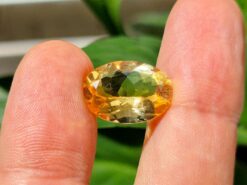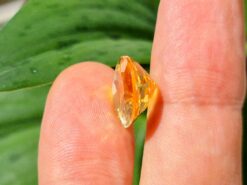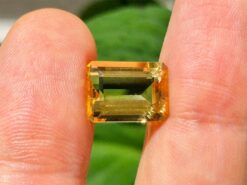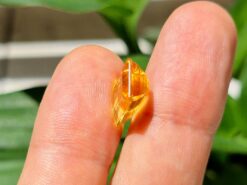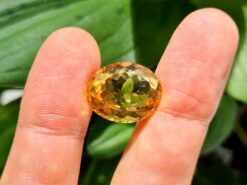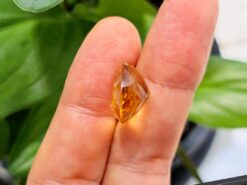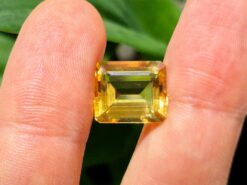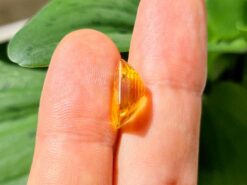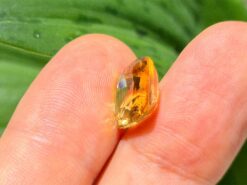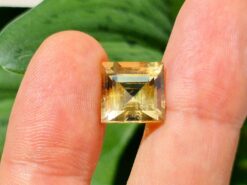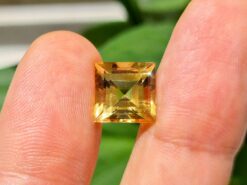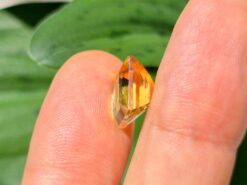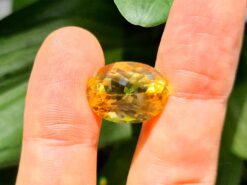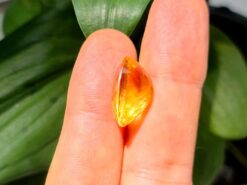Citrine
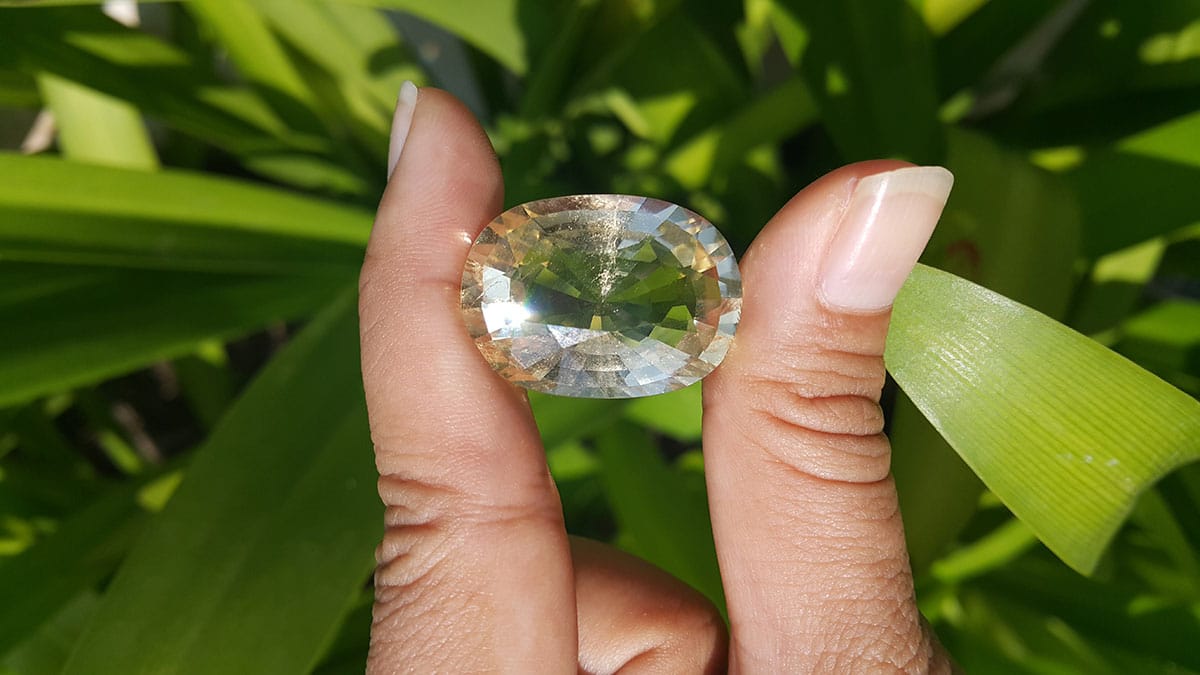
Citrine crystals stone meaning, the November birthstone. We make custom jewelry with cut or raw citrine gemstone set as earrings, rings, necklace, bracelet or pendant.
Buy natural citrine in our shop
A variety of quartz. The citrine color ranges from a pale yellow to deep orange. It s due to ferric impurities. Natural gemstone rare. Many commercial stones are amethysts or also smoky quartz having undergone a heat treatment. However, a heat-treated amethyst will have small lines in the crystal. As opposed to a natural stone’s cloudy or smokey appearance.
It is nearly impossible to differentiate between cut a stone and yellow topaz visually. But they differ in hardness. Brazil is the leading producer of citrine gemstone. Almost of its production coming from the state of Rio Grande do Sul. The name comes from the Latin word citrina. It means yellow and is also the origin of the word citron.
History
Citrine stone was first appreciated as a golden-yellow gemstone in Greece. Between 300 and 150 BC. During the Hellenistic Age. The yellow quartz was used prior to that to decorate jewelry and tools. But it was not highly sought-after
Citrine 33.64 ct, from Takeo, Cambodia
Quartz
Quartz is a mineral. Its composition is silicon and oxygen atoms. In a continuous framework of SiO4 silicon–oxygen tetrahedra. With each oxygen being shared between two tetrahedra. Giving an overall chemical formula of SiO2. It is also the second most abundant mineral in Earth’s continental crust, behind feldspar.
There are many different varieties of quartz. They are semi-precious gemstones. Since antiquity, varieties of quartz have been the most commonly used minerals. In the making of jewelry and hardstone carvings. Especially in Eurasia.
November birthstone
Those with November birthdays have two beautiful birthstones to choose from topaz and citrine birthstone crystals. Topaz comes in a rainbow of colors, the stone is prized for its charming yellow and orange hues. Both November birthstones are known to have calming energies while bringing fortune and warmth to the wearer
Yellow color
Yellow citrine color is a reference for certain colored varieties of quartz which are a medium deep shade of golden yellow color. The stone has been summarized at various times as yellow color, greenish-yellow, brownish yellow or orange.
The original reference point for the yellow color was the citron fruit. The first recorded use of the gemstone as a color in English was in 1386. In late medieval and early modern English the color name was applied in a wider variety of contexts than it is today and could be reddish or brownish yellow color, or orange, or amber.
Citrine meaning and healing properties benefits
The following section is pseudo scientific and based on cultural beliefs.
The citrine spiritual meaning is its yellow hues symbolizing the spiritual qualities of joy, abundance, and transmutation. Like a refreshing glass of lemonade, It can bring a quick, energetic pick-me-up to those who use it with diligence and respect.
In times of low to moderate stress, The stone is a perfect ally for realigning your energies back into balance. In contrast, other, more powerful crystals may be necessary for more profound healings.
Third Solar Plexus Chakra stone
Stimulating Citrine is an energizing yellow stone that carries the personal power of the sun. The crystal does not hold negative energy, and never needs cleansing. It dispels anger and cleanses the aura.
It energizes, increases motivation, and heightens self-esteem, personal power, and creativity. It brings happiness and generosity, promotes inner calm, and balances yin yang energy.
The crystal may enhance concentration, and is excellent for overcoming depression, fears and phobias. It is a good stone to use for manifesting your desires and creating optimism.
Citrine under microscope
FAQ
What are citrine crystals good for?
How citrine works? It can help strengthen self-esteem and a positive, vibrant flow of energy in and around one’s body. It is also considered helpful in improving digestion and strengthening one’s physical endurance. Throughout history and in many cultures stones was known as the merchant’s stone.
What chakra is citrine associated with?
how the crystal works with chakra? It is one of the essential stones of the sacral chakra, making it a staple for creativity and manifestation. This resonance with the sacral chakra allows one to awaken their abilities of creative imagination.
How much is a citrine worth?
The most highly valued citrine color is a deep red-orange valued at around $30 dollars per carat, and found most often in Brazil – gemstones of this color are sometimes called fire citrine. The lighter varieties of pale yellow gemstone color, found often in Bolivia, have a lower value of around $10 dollars per carat
Can you wear citrine everyday?
Wearing it daily is the best way to capture the personal power of the stone and wearing it with another bracelet will only help to amplify your desires.
What power does citrine have?
It is believed to be of value in healing the spiritual self as well, as it is a powerful cleanser and regenerator. It carries the virtues of self-healing, inspiration and self-improvement. Carrying the personal power of the sun, it is excellent for overcoming depression, fears and phobias.
Which citrine is best?
In general the most highly valued color is the deeply saturated reddish orange color, most often found in Brazil although Uruguay produces some wonderful colored stones. The golden orange to almost reddish brown Madeira gem is a good example of the most sought after color.
Where do you wear a citrine ring?
A ring should be worn on the index finger of the right hand. Make sure to wear it on a Thursday morning during Shukla Paksh before sunrise.
How to work with citrine, solar plexus for self confidence?
Place it on your third chakra or solar plexus chakra for 10-15 minutes in the morning and evening with the intention to improve your self-confidence or self-worth.
Make sure to cleanse this stone as it absorbs negativity from your aura and environment all day. You can place it in a bowl of rice by your bedside during the night and charge it with your affirmation in the morning.
Natural citrine for sale in our gem shop
We make custom made citrine jewelry as engagement rings, necklaces, stud earrings, bracelets, pendants… Please contact us for a quote.

